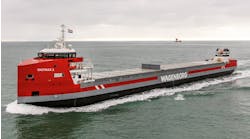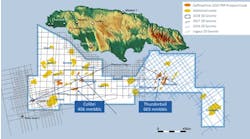Mediterranean pipeline network evolving based on Adriatic and Libya developments
Jeremy Beckman
Europe Editor
The SAF subsea production system in its final production configuration.
International markets are important to Agip's aims of becoming one of the world's top ten petroleum revenue earners. A recent report said that the company was setting aside $5.3 billion over the next four years for exploration and development projects overseas, notably in China and the Former Soviet Union.
But the report also stated that Agip would concentrate increasingly on natural gas schemes. Gas demand is widely predicted to soar across Europe, North Africa and the Middle East in the next two decades - and where better to source this than Agip's historical powerbase, the Mediterranean?
The next few years will bring increased development activity by the company in fields off Italy and Libya, as well as through combines in Egypt. Major new pipelines are being contemplated in the region, along with establishment of new LNG import terminals to treat supplies from West Africa and the Middle East.
Alto Adriatico
Next year, Italian consumers will see first benefits of the $750 million Alto Adriatico development. This project is tying in 15 marginal gasfields in the northern Adriatic Sea, close to the Po river delta, which were discovered between 1975 and 1985.
To garner this gas, two central production platforms, Aida A and Donatella A, will be installed along with accommodation facilities. They will act as hosts to sixteen unmanned satellite production platforms, and the Aida T compression platform, equipped with four 4,800 kW compression modules. Water depths range from 22-38 meters.
To reduce Capex, the satellites consist of two standard designs of four or six-slot platforms known as BEAF (low energy, high reliability, developed with Snamprogetti). At least 82 wells will be drilled and a network of 260 km of sealines will be laid to collect gas from the platforms, then route it through Aida T onshore to Casalborsetti via an 80km, 24-in. export trunkline. A Scada system at the Casalborsetti gas treatment plant will be used to control the platforms remotely.
First gas is due out from Aida A late in 1996, with peak production of 11.5mcf/d in 1999. More discoveries could be tied in later, following a successful recent 3D seismic appraisal of the area. Reserves are thought to exceed 1.1tcf.
One problem Agip has to counter is subsidence in the Ravenna area. This was mainly caused by withdrawal of fresh water from the underlying aquifers up to the middle 1980s, leading to ground levels dropping 4 meters in certain areas. Currently, certain individuals in the local agricultural industry are linking continued coastal zone subsidence of 2-3 cm a year to the multi-field development.
According to Agip's CEO, president and chairman, Guglielmo Moscato, these people are trying to delay the project, even though the situation is not Agip's fault. Only one field in Alto Adriatico, Chioggia, is close to the shore, he points out. Nevertheless, Agip agreed to co-operate in a local subsidence prediction and monitoring project, and is prepared to inject water in case subsidence affects the shore.
In the Ionian Sea, 5-7 km offshore Crotone, Agip is working on another gas development for its Luna and Hera Lacinia Fields. A new subsea well is being drilled in 175 meters water depth, which will be connected to existing platforms on Luna A and B by flexible flowlines and an umbilical.
Near to this well (Luna 40) will be installed the small Hera Lacinia platform, from which five infill wells will be drilled, four of them to recover 3.5 bcm of gas. An existing sealine will be used to transport gas from all the new wells to a treatment plant at Crotone for dehydration and compression.
For this project Agip will deploy for the first time the SAF technology developed by Kvaerner Energy, Snamprogetti and Tecnomare. SAF is a modular subsea production system integrated with an ROV-based installation and maintenance system, designed to work in water depths down to 1,000 meters. The latter will also be used to connect the xmas tree to the flowline termination.
Egypt venture
Last December, Agip, Amoco and Egypt Gas Co. signed up for a proposed new $300 million venture called Egypt Trans-Gas Company. They aimed to cover all aspects of gas distribution and transport within Egypt, but would also consider a gas export pipeline to eastern Mediterranean countries right up to Lebanon.
In recent times the partners have found gas on the Temsah concession in the Gulf of Suez and also the Nile Delta. Agip is also drilling to appraise gas-bearing structures found in its NC41 permit off Libya. Bearing in mind this and other gas strikes in the Sahara, Agip has sounded out Algeria, Libya and Tunisia about the possibility of a further pipeline to Italy.
This would complement the two Transmed lines carrying gas from Tunisia to Sicily. Location would depend on seabed topography. A line from Libya in 500 meters water depth would be economically and technically feasible, says Moscato, but further east, where depths drop to 3,000 meters, it wouldn't.
An alternative would be to use floating terminals based in the Mediterranean for unloading, storage and regasification of LNG imported by vessels from fields in West Africa, North Africa or the Middle East. Tecnomare has performed a study of such a system for Agip, based in the Adriatic Sea.
The terminal would comprise a tanker-type, double hull vessel, permanently moored 15 km from the mainland in water depth via a single point mooring system. It would be able to handle imports of 6 mcm/year. But it has also been suggested that some of the Adriatic's platforms awaiting decommissioning could be instead converted for LNG reception.
For a trans-Mediterranean gas network to succeed, tensions must first be overcome between the Christian countries in the north of the region and Islamic nations in the south, suggested Moscato in his keynote speech at March's Offshore Mediterranean Conference in Ravenna.
Regional infrastructure needs to be expanded, he said, based on a cohesive energy development plan. "We must set up more joint ventures and develop more gas fields to foster industrial symbiosis between the different nations."
Territorial dispute
Symbiosis isn't in great supply currently between Italy and Malta. The latter offered designated offshore blocks Areas 3, 4 and 5 to operators last October, but Italy is claiming jurisdiction over this acreage. Libyan interests are also affected. Agip is interested in one of the areas covering the Medina Banks, says Moscato.
In the eastern Adriatic, Agip plans to drill a well with Chevron in deepwater acreage following a big seismic program. Discussions continue between Agip and Croatia about exploration possibilities in their waters.
Abandonment is a key issue currently for Agip and other operators in the Adriatic. Since 1967, over 100 platforms have been installed off Italy, ranging from monopods and four-legged wellhead structures to conventional eight-legged, self-contained installations. During the past five years, 15 small wellhead platforms have been either removed or left in place as artificial reefs. Amongst these are Agip's Paguro platform, which sank a few years ago and is now a marine park, according to Moscato.
However, more platforms are due to cease operating. Under IMO guidelines, all platforms standing in less than 75 meters and weighing less than 4,000 tons should be entirely removed. This applies to many of the Adriatic installations, which are sited in water depths ranging from 2-120 meters.
Agip, like all operators, is concerned about the costs of removal. It would like to see fiscal incentives from Italy's government. The problem is that government has changed due to Italy's unstable political situation, and may change again shortly following fresh elections.
Gulf developments
In the Gulf of Mexico, Agip is currently reaping 89 MMcf/d and 14,000 b/d of oil from two operated fields and one non-operated field. At its largest operation, Grand Isle 102, a second platform is being installed, due onstream next year, which will add 90 MMcf/d and 2,500 b/d of condensate to the field's production capacity.
Later this year production facilities will be installed on a recent gas discovery in South Marsh Island. And a subsea development is under way in the East Breaks area. Two subsea wells in water depths near 300 meters will be connected to an offsetting platform for an anticipated production start next year.
According to Moscato, Agip will invest nearly $150 million in the US Gulf between now and 1998. Altogether, it has interests in 18 exploratory licenses: exploration will continue in these and in the sub-salt trend.
Elsewhere in the offshore world, Agip as operator has received approval from its partners for the $350 million Kitina development offshore Congo. A platform with 16 wells will be installed to tap the field's 120 MM bbl of oil, beginning summer 1997.
In Southeast Asia, Agip has not received or sought special overtures concerning exploration off Vietnam. "Our first priority is China," says Moscato, including the South China Sea where Agip has developments as part of the ACT consortium with Chevron and Texaco.
Copyright 1995 Offshore. All Rights Reserved.




